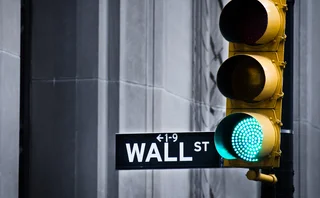
Optional extras
The recent launch of two basket-linked notes – Trac-x and iBoxx – has given rise to a market in options that uses these indices as the underlying. Alan McNee looks at how this fast-growing instrument works

Until recently, options on underlying assets were considered among the most exotic of credit derivatives. But with the introduction of basket-linked notes, which allow investors to buy and sell exposure to a pool of underlying credits in one trade, a market for options using these indices as the underlying is beginning to emerge.
Two major basket-linked notes were launched earlier this year. JPMorgan and Morgan Stanley merged their existing products to create Trac-x, and ABM Amro and Deutsche Bank launched iBoxx. And with more banks signing up as market makers to both products, Trac-x and iBoxx are quickly becoming accepted methods for trading credit market risk. The fact that the indices trade in an unfunded format means investors do not have to risk money up front, providing an extra incentive to trade on them. The ability to trade these indices and find reliable pricing has spurred demand for options on the back of the indices.
Sunil Hirani, CEO of New York-based inter-dealer credit derivatives broker Creditex, says the volume of options traded on credit indices has risen in the past couple of months, and although volumes remain low – with Creditex still seeing the number of trades per week in single digits – he expects liquidity to grow further.
“With the indices themselves already providing an efficient way to take a directional view on credit markets, credit index options are an efficient tool to get leveraged access to credit spreads,” says Hirani. “On the back of this, many banks are creating new structured products in both funded and unfunded forms that have options embedded in them.” Options on the indices can then be used to hedge these products.
The bulk of demand is for options based on the iBoxx and Trac-x indices. Brad Poprik, co-head of the North American structured credit trading desk at Deutsche Bank, says: “We’re now making markets for options three and six months out on Trac-x in North America and for the same periods on the iBoxx in Europe.”
Joining the mainstream
Although credit options originated from bonds and single-name credit default swaps, they are only now beginning to become mainstream thanks to tradable indices. An option on the Trac-x North America index, for example, might involve the buyer agreeing with the seller that if the spread on Trac-x reaches a certain level in three months’ time, it will have the option to purchase protection at that time at a pre-determined level. Options to buy or sell Trac-x typically trade in $25 million lots, with straddles trading in $50 million lots, and mostly in the three-month maturity period.
Lisa Watkinson, global product manager for indexation products at Morgan Stanley in New York, says liquidity in the underlying is key to the index’s popularity. “The important thing about Trac-x is that the underlying really does trade, so dealers who are active on Trac-x are usually also doing trades on the underlying,” she says.
It is this standardization and liquidity that explains why the index is so far enjoying much more active trade than single-name default options. “The beauty of the index is that there is natural two-way demand,” adds Deutsche Bank’s Poprik. “People perceive the indices to be representative of the market, even if that’s not necessarily the case.” The liquidity in the index means that if market participants want to trade volatility, it is perceived to be the cleanest way to do so.
“There’s a clear sense of where volatility trades and the reassurance that if you buy volatility, you will have avenues through which to sell it back,” says Poprik. “You don’t necessarily get that with single names.”
A fund might use options on Trac-x or iBoxx if it has gone either long or short on distressed debt, expecting the bonds to either default or improve. The fund may be happy enough with its view on individual credits, but is still concerned about more macro risk, which could cause the whole sector to blow up. The fund could enter into ‘right-to-buy’ protection, which allows it to go neutral on the market but retain its exposure to individual credits. This is cheaper than buying the index outright, and since the fund will not know at that stage whether it needs to buy the index outright in future, it makes sense to buy an option more cheaply in the meantime.
Single-name trade
While most credit options trade is still based on the indices launched earlier this year, dealers say a nascent market in single-name credit default options is emerging. Deutsche Bank’s Poprik says that although this is a relatively new market, there was nevertheless demand from clients for credit default options as far back as five or six years ago.
“At that time,” says Poprik, “the technology limitations of customers and the fact that there was much less demand for credit volatility as a traded instrument made it difficult to trade.” In the current low spread environment, he says, there is much more demand for volatility and so it is possible to make liquid markets.
Ian Clague, head of the global exotic credit derivatives desk at inter-dealer brokerage GFI, says he is starting to see interest from clients in transacting single-name credit default options on high-quality names such as Ford. So far, active trade is limited to about five high-quality names in North America and a similar number in Europe. The ideal credits to attract liquidity are those that combine decent credit quality with some liquidity or interest in the credit. “There needs to be some volatility in order for people to choose default swap options on the credit,” says Clague.
Dik Blewitt, managing director, global structured products at Banc of America Securities, says BoA is in the process of quoting options on single-name credit default swaps as well as on bespoke tranches of credit risk. “Single-name default options and options on tranches are increasingly being looked at and entered into by hedge funds,” he says.
“They have a lot of cash available, see relative value in these transactions and most importantly they like the liquidity that has developed,” adds Blewitt. “An integral part of the development of these products is the underlying secondary market – it’s where the dealers hedge, and functions as the main driver in determining fair value. Both dealers and customers need to know their mark-to-market value each day, and like to know they can get both in and out.”
One of the problems with options on single-name credit default swaps is what happens when the reference entity defaults. Clearly it is almost impossible for all the components of an index to default, so this problem does not exist when basket-linked notes are used as the underlying. The issue of restructuring, which affected the credit derivatives markets, has now been largely overcome thanks to the standardized documentation now used in the credit default swap markets.
Problems remain, however, in the form of disagreement over whether options should ‘knock out’ upon default. In other words, if a reference entity defaults, should the option become invalid? Dealers say the options which do not knock out upon default are attracting most liquidity, since obviously they provide greater protection. But single-name options that do knock out upon default are still being marketed, largely as a result of limitations in options modeling theory. It is simpler to model the price of an option on the basis of no default.
Other obstacles to the market’s development have been the relatively wide spreads being quoted until recently and the difficulty of calculating – and finding buyers for – implied volatility. Both these factors are starting to move in favor of options dealers.
“Implied volatility is now observable in the credit markets for the first time,” says GFI’s Clague. “Implied volatility has come down as credit spreads have come in from around 85bp three months ago to about 65bp at present on the Trac-x US, and from 60bp down to about 44bp in the same period on Trac-x Europe.” Deutsche Bank’s Poprik says further tightening of spreads would be “a major factor in the growth of single-name default options” and notes that as recently as four months ago his bank had few enquiries about these products – “yet now we’re making fairly liquid markets”.
Only users who have a paid subscription or are part of a corporate subscription are able to print or copy content.
To access these options, along with all other subscription benefits, please contact info@risk.net or view our subscription options here: http://subscriptions.risk.net/subscribe
You are currently unable to print this content. Please contact info@risk.net to find out more.
You are currently unable to copy this content. Please contact info@risk.net to find out more.
Copyright Infopro Digital Limited. All rights reserved.
You may share this content using our article tools. Printing this content is for the sole use of the Authorised User (named subscriber), as outlined in our terms and conditions - https://www.infopro-insight.com/terms-conditions/insight-subscriptions/
If you would like to purchase additional rights please email info@risk.net
Copyright Infopro Digital Limited. All rights reserved.
You may share this content using our article tools. Copying this content is for the sole use of the Authorised User (named subscriber), as outlined in our terms and conditions - https://www.infopro-insight.com/terms-conditions/insight-subscriptions/
If you would like to purchase additional rights please email info@risk.net
More on Credit markets
Single-name CDS trading bounces back
Volumes are up as Covid-driven support fuels opportunity for traders and investors
Podcast: Richard Martin on improving credit migration models
Star quant proposes a new model for predicting changes in bond ratings
CME to pass on Ice CDS administration charges
Clearing house to hike CDS index trade fees from July after Ice’s determinations committee takeover
Buy side fuels boom in single-name CDS clearing
Ice single-name CDS volumes double year on year following switch to semi-annual rolls
Ice to clear single-name bank CDSs from April 10
US participants will be able to start clearing CDSs referencing Ice clearing members
iHeart CDS saga sparks debate over credit rules
Trigger decision highlights product's weaknesses, warns Milbank’s Williams
TLAC-driven CDS index change tipped for September
UK and Swiss bank Holdco CDSs likely inclusions in next iTraxx index roll, say strategists
Fears that bumper coupon could skew iHeart CDS payouts
Market pushes for change to auction date amid fears of reduced single-name and index CDS payouts
Most read
- Top 10 operational risks for 2024
- Japanese megabanks shun internal models as FRTB bites
- Top 10 op risks: third parties stoke cyber risk







